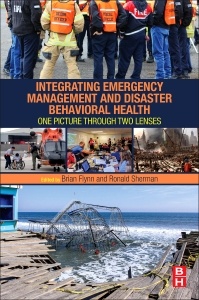Integrating Emergency Management and Disaster Behavioral Health One Picture through Two Lenses
Coordonnateurs : Flynn Brian, Sherman Ronald

Integrating Emergency Management and Disaster Behavioral Health identifies the most critical areas of integration between the profession of emergency management and the specialty of disaster behavioral health, providing perspectives from both of these critical areas, and also including very practical advice and examples on how to address key topics.
Each chapter features primary text written by a subject matter expert from a related field that is accompanied by a comment by another profession that is then illustrated with a case study of, or a suggested method for, collaboration.
Section I: Context 1. Where Emergency Management and Disaster Behavioral Health Meet: Through an Emergency Management Lens 2. Where Emergency Management and Disaster Behavioral Health Meet: Through a Disaster Behavioral Health Lens 3. Why Is Integrating Disaster Behavior Health Essential to Emergency Management? Challenges and Opportunities 4. Why Is Integrating Emergency Management Essential to Disaster Behavioral Health? Challenges and Opportunities
Section II: Key Areas of Integration 5. Integration in Disasters of Different Types, Severity, and Location 6. Not All Disasters Are the Same: Understanding Similarities and Differences 7. What Can DBH Actually Do To Make Emergency Managers Jobs Easier? 8. Expanding the Tent: How Training and Education Partnerships with Other Professions Can Enhance Both EM and BH 9. Linking with Private Sector Business and Industry
Section III: Special Opportunities to Enhance Integration 10. Integration in the Emergency Operations Center (EOC)/Emergency Communications Center (ECC) 11. Risk and Crisis Communications 12. How to Navigate External Factors: Legal, Ethical, and Political Issues 13. Sustaining Integration: A Way Forward 14. Conclusion/Summary
Ron Sherman spent almost 29 years as an emergency management specialist with the Federal Emergency Management Agency. He worked on over 200 federal disaster operations, including some of this nation’s most devastating events. Many times during his career he was in the role of Federal Coordinating Officer (FCO), the on-site official in charge of all Federal response and recovery efforts. After Hurricane Katrina Ron served as the FCO in Alabama before becoming the Senior Housing Official responsible for disaster housing operations for the entire Gulf Coast. After retiring in 2007 he continued his emergency management involvement by starting a Citizen Corps Council in his hometown and is now the leader of a Community Emergency Response Team. He provides emergency management consulting services to communities and emergency response training for volunteer groups. He has successfully integrated the operations of a Community Emergency Response Team with a new Medical Reserve Corps team a
- Addresses the current state of the collaboration between the emergency management and disaster behavioral health communities as presented from pioneers in their respective fields
- Focuses on practical examples of what works and what doesn’t
- Stresses both legal and ethical considerations and the public-private partnerships that are important for leadership in disaster situations
- Covers Emergency Operations Centers (EOCs) and risk communication
Date de parution : 01-2017
Ouvrage de 370 p.
15x22.8 cm
Thèmes d’Integrating Emergency Management and Disaster Behavioral... :
Mots-clés :
Adaptability; All hazard planning; And risk assessments; Assistant Secretary for Preparedness and Response; Behavioral health; Behavioral health consultation; Behavioral health practitioner; Behavioral health training; Binghamton shooting; Boston Marathon Bombing; Cluster system; Collaboration in disasters; Communications; Complex systems; Confidentially; Credibility; Crisis Counseling Program; Crisis communication; Deaf Mexicans; Disaster; Disaster behavioral health; Disaster credentials; Disaster management; Disaster mental health; Disaster needs assessment; Disaster preparedness; Disaster psychology; Disaster recovery; Disaster response; Disaster worker stress; Disaster workforce health protection; Disasters; ESF-8; Ebola response; Education; Emergency communications center; Emergency management; Emergency management professionals; Emergency operations center; Emergency preparedness; Emergency support function 8; Ethics; Federal Emergency Management Agency; Federal Response Plan; First responders; Funding; Hazard; Incident command; Incident command system; Integration; Interdisciplinary approaches; Leadership; Legislation; Licensure; Logistics; Mass casualties; Massage mapping; Mental health; Mental health psychosocial support; National Incident Management System; National Response Plan; National incident command system; Politics; Positioning theory; Promoting integration; Psychological stress; Public health; Public information; Resilience; Resources; Respect; Risk communication; Scalability; Self-care; Situation report; Stress management; Substance use disorder; Sustaining integration; Threat; Traumatic stress; Trust; Whole community; Yonkers mudslide



